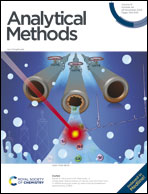A dually emissive MPA-CdTe QDs@N, S-GQD nanosensor for sensitive and selective detection of 4-nitrophenol using two turn-off signals†
Abstract
4-Nitrophenol (4-NP) is an extremely poisonous and carcinogenic phenol that poses serious health issues to humans. Therefore, it becomes highly demanded and urgent to determine 4-NP in water samples. In this study, we developed a facile and effective dually-emissive nanosensor containing simply mixed CdTe quantum dots (CdTe QDs) and N, S modified graphene quantum dots (N, S-GQDs) for 4-NP. The synthesized CdTe QDs and N, S-GQDs exhibited excitation-independent emission located at 540 nm and 420 nm, respectively. The nanosensor displayed two turn-off fluorescent signals when exposed to 4-NP. The degree of quenching varied depending on the excitation wavelength range used, which can be explained by the quenching phenomenon based on the inner filter effect (IFE). Moreover, analysis of the recorded excitation-emission matrix (EEM) data using the parallel factor analysis (PARAFAC) technique revealed a negative emission spectrum corresponding to non-emissive 4-NP. On the other hand, the species with no peak in fluorescence data had a negative spectrum as the PARAFAC emission loading. Under the optimized conditions, the CdTe QDs@GQD nanosensor achieved fast and highly sensitive detection of 4-NP within the concentration range of 0.0–30.0 μM, with a detection limit of 0.52 μΜ.



 Please wait while we load your content...
Please wait while we load your content...